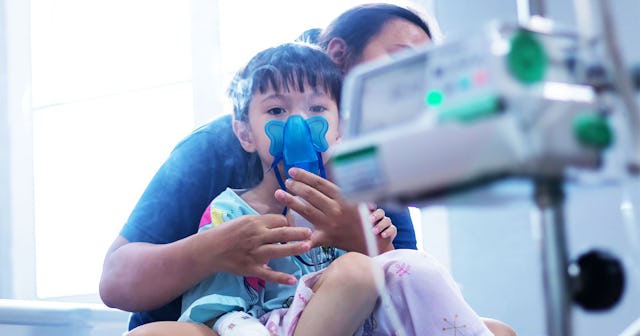Fewer Kids Are Going To The ER For Asthma During The Pandemic: Here’s Why

Childhood asthma is one of the most common long-term pediatric diseases. Because it affects the lungs, both adults and children who have asthma have reason to be extra cautious due to the coronavirus.
However, according to a recent study published in Annals of the American Thoracic Society, a week after Massachusetts closed schools and daycares in March 2020, there was an 80% drop compared to the previous two months in asthma-related visits to the Boston Children’s Hospital ER. At the end of May two months later — when the stay-at-home order started to lift — the ER had similar numbers. Compared to 2018 and 2019 asthma emergency visits, the May 2020 numbers were 82% and 87% fewer respectively.
Lead study author and pediatric pulmonologist Dr. Tregony Simoneau told NPR that though she had anticipated a decline of asthma-related visits similar to that of the decline over summer breaks, “the sustained nature of it and the dramatic drop were surprising.”
It would be understandable to attribute the decline to emergency room avoidance — basically reducing unnecessary visits to the ER by properly determining if a visit is truly an emergency — in particular during the pandemic due to fears of contracting COVID-19 or overwhelming emergency medical resources.
In fact, a few weeks ago, my four-year-old son was having difficulty breathing at 10 p.m. after he vomited all over me in the bathroom. Pre-pandemic, I would have had zero hesitation about driving immediately to our local emergency room — $350 copay and all. After all, breathing is fundamental. But California was in the midst of stay-at-home orders. I questioned if it was safe to go — and attempted the COVID calculus of deciding which would be statistically worse: staying home and riding out my youngest’s labored breathing, or risking possible infection at the emergency room. I can only imagine how parents of kids with asthma would worry even more about the coronavirus.
SDI Productions/Getty
Surprisingly, the authors of the study suggested that emergency room avoidance wasn’t the only reason for the drop in children heading to the ER for asthma incidents and indicated pandemic-induced changes in circumstances — whether individual, community, or environmental — as other reasons. Mostly because compared to other ER visits of children 2 to 22 years old, the study observed a much sharper decline in asthma-related emergencies. This remained the case across ethnicities, and when compared to the two months prior to the Massachusetts stay-at-home order and the same time periods during the years 2018 and 2019.
Furthermore, since the hospitalization rate of children with asthma emergencies did not increase, the authors suggested that the most of the cases which made it to the ER weren’t worse than pre-stay-at-home order times.
Why kids are going to the ER for asthma less during the pandemic
So, if it isn’t because parents are wary of bringing their kids into hospitals, or just executing better judgment about what constitutes an emergency, what are some other factors for why kids are going less to the ER for asthma emergencies? In a Children’s Hospital of Philadelphia (CHOP) and Hospital of the University of Pennsylvania study published in August 2020, the findings corroborated those of Boston Children’s Hospital in terms of factors contributing to the decline.
Increased medical adherence
For patients with asthma, proper usage of daily controller medication was extremely important during the coronavirus pandemic due to the medicine increasing positive outcomes and decreased respiratory setbacks. However, the Centers for Diseases Control and Prevention (CDC) estimates only 54% of children who take medication use them as prescribed, thus increasing both the occurrence and severity of asthma attacks.
Dr. Simoneau told NPR she’d observed patients and families taking a proactive approach, refilling their controller and rescue inhalers more frequently and earlier, as well as using their medications on a more regular basis.
Karl Tapales/Getty
Better implementation of preventative measures
Asthma in children can be exacerbated or triggered by the common cold but due to increased public health measures because of the pandemic, doctors have reported fewer infections from rhinoviruses and other common cold viruses. Thus preventative hygiene such as limited exposure to others, constant hand washing and disinfecting of surfaces, and adherence to the CDC COVID-19 guidelines have led to lower viral infections, thus also decreasing the number of asthma cases set off by the cold.
Increased access to telemedicine
Because of the fear of possibly contracting COVID-19, ER visits may have also decreased as more patients have taken advantage of telemedicine. Because televisits can often be easier and more convenient to schedule, patients and parents may seek treatment earlier and have access to medical care sooner and before symptoms worsen — thereby decreasing the risk of asthma emergencies in children.
It must be noted, however, that recent research suggests that Black and Latinx patients and families utilize telemedicine on much lower levels when compared to their white counterparts. According to the 2018 National Healthcare Quality and Disparities (NHQD) Report, there are enduring inequalities for Black patients as compared to white patients, such as hospital admissions for asthma among children aged 2 to 17.
Improved environmental factors
Lastly, due to social distancing, virtual schooling, and shelter-in-place orders limiting outside exposure and environmental pollution — children may also be limiting their exposure to asthma triggers such as viruses, pollen, and pollution,
Whether it’s continuing a mask-wearing culture or better adherence to medication or preventative hygiene measures, it is hoped that by examining these causes further, doctors can also come up with applications post-pandemic to keep the rate of kids going to the ER for asthma this low.
This article was originally published on